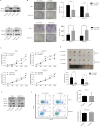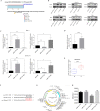MiR-155-5p suppresses SOX1 to promote proliferation of cholangiocarcinoma via RAF/MEK/ERK pathway
- PMID: 34876142
- PMCID: PMC8650398
- DOI: 10.1186/s12935-021-02374-0
MiR-155-5p suppresses SOX1 to promote proliferation of cholangiocarcinoma via RAF/MEK/ERK pathway
Abstract
Background: Accumulating evidence has demonstrated the close relation of SOX1 with tumorigenesis and tumor progression. Upregulation of SOX1 was recently shown to suppress growth of human cancers. However, the expression and role of SOX1 in cholangiocarcinoma (CCA) is not well characterized.
Methods: Expression levels of SOX1 in CCA tissues and normal bile duct tissues were examined using public GEO database. Western blot and immunohistochemistry were used to confirm the expression levels. Cell proliferation assay (CCK-8) and colony formation assay were performed to assess proliferation of CCA cells. A mouse model of subcutaneous transplantable tumors was used to evaluated proliferation of CCA in vivo. The putative regulating factor of SOX1 were determined using Targetscan and dual-luciferase reporter assay.
Results: SOX1 was downregulated in CCA tissues. Overexpression of SOX1 significantly inhibited cell proliferation in vitro and suppressed tumor growth in vivo. miR-155-5p directly targeted the 3'-untranslated region (3'UTR) of SOX1 and inhibited expression of SOX1, resulting in the activation of RAF, MEK and ERK phosphorylation, and thus CCA proliferation. However, restoration of SOX1 expression in miR-155-5p overexpressing cell lines decreased the phosphorylation level of RAF, MEK and ERK, as well as the proliferation of CCA cells.
Conclusion: MiR-155-5p decreased the expression of SOX1 by binding to its 3'UTR, which activated the RAF/MEK/ERK signaling pathway and promoted CCA progression.
Keywords: Cholangiocarcinoma; ERK; RAF; SOX1; miRNA.
© 2021. The Author(s).
Conflict of interest statement
The authors declare that they have no competing interests.
Figures






Similar articles
-
MiR-192-5p regulates the proliferation and apoptosis of cholangiocarcinoma cells by activating MEK/ERK pathway.3 Biotech. 2021 Feb;11(2):99. doi: 10.1007/s13205-021-02650-w. Epub 2021 Jan 28. 3 Biotech. 2021. PMID: 33552829 Free PMC article.
-
Profiling of downregulated blood-circulating miR-150-5p as a novel tumor marker for cholangiocarcinoma.Tumour Biol. 2016 Nov;37(11):15019-15029. doi: 10.1007/s13277-016-5313-6. Epub 2016 Sep 22. Tumour Biol. 2016. PMID: 27658773
-
LncRNA HOTAIR suppresses cell apoptosis, autophagy and induces cell proliferation in cholangiocarcinoma by modulating the miR-204-5p/HMGB1 axis.Biomed Pharmacother. 2020 Oct;130:110566. doi: 10.1016/j.biopha.2020.110566. Epub 2020 Aug 2. Biomed Pharmacother. 2020. PMID: 32755793
-
HCG18 Promotes Cell Proliferation and Stemness in Cholangiocarcinoma via the miR-194-5p/KRT18/MAPK Signaling.Biochem Genet. 2025 Jan 8. doi: 10.1007/s10528-025-11020-7. Online ahead of print. Biochem Genet. 2025. PMID: 39776371
-
Apatinib affect VEGF-mediated cell proliferation, migration, invasion via blocking VEGFR2/RAF/MEK/ERK and PI3K/AKT pathways in cholangiocarcinoma cell.BMC Gastroenterol. 2018 Nov 6;18(1):169. doi: 10.1186/s12876-018-0870-3. BMC Gastroenterol. 2018. PMID: 30400838 Free PMC article.
Cited by
-
Comment on "The Diagnostic and Prognostic Value of miR‑155 in Cancers: An Updated Meta‑analysis".Mol Diagn Ther. 2024 Jul;28(4):507-508. doi: 10.1007/s40291-024-00710-4. Epub 2024 May 23. Mol Diagn Ther. 2024. PMID: 38780684 No abstract available.
-
ERK1/2 Signaling in Intrahepatic Cholangiocarcinoma: From Preclinical Advances to Therapeutic Strategies.Biology (Basel). 2025 Jun 27;14(7):776. doi: 10.3390/biology14070776. Biology (Basel). 2025. PMID: 40723336 Free PMC article. Review.
-
SOX1 acts as a tumor hypnotist rendering nasopharyngeal carcinoma cells refractory to chemotherapy.Cell Death Discov. 2023 Jun 27;9(1):194. doi: 10.1038/s41420-023-01479-x. Cell Death Discov. 2023. PMID: 37369660 Free PMC article.
-
The H2A.Z-KDM1A complex promotes tumorigenesis by localizing in the nucleus to promote SFRP1 promoter methylation in cholangiocarcinoma cells.BMC Cancer. 2022 Nov 11;22(1):1166. doi: 10.1186/s12885-022-10279-y. BMC Cancer. 2022. PMID: 36368958 Free PMC article.
-
Role of the SOX family in cancer immune evasion: Emerging player and promising therapeutic opportunities.Medicine (Baltimore). 2025 Jan 31;104(5):e41393. doi: 10.1097/MD.0000000000041393. Medicine (Baltimore). 2025. PMID: 39889187 Free PMC article. Review.
References
Grants and funding
LinkOut - more resources
Full Text Sources
Research Materials
Miscellaneous

